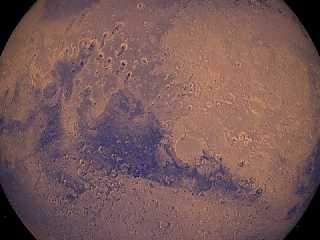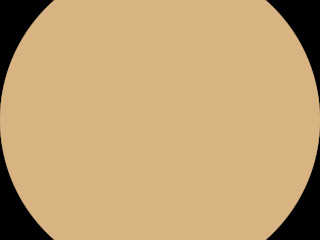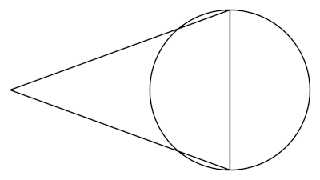 |
 |
|
 |
|
 |
|  |
|  |
|
 |
|
 |
|  |
|  |
|
 |
High!
To implement a LOD (level of detail) system for large surface textures
of planets in my Solar System model, I started with testing the FOV
width in POV units corresponding to camera distance and angle.
As the horizontal image width (in POV units) as
camera_distance*tan(angle/2), a sphere with a radius of 3396.2 units
(the planet Mars) should exactly fit into the camera window when viewed
from a distance of 9330.982812 units - but instead the planet's disc is
still too large for the image (see attachment)! Obviously, "angle 40"
does not give really a 40-degree FOV, but a somewhat narrower one... or
what else did I get wrong?
See you on www.khyberspace.de!
Yadgar
Post a reply to this message
Attachments:
Download '2009-05-03 mars, take 3.jpg' (102 KB)
Preview of image '2009-05-03 mars, take 3.jpg'

|
 |
|  |
|  |
|
 |
|
 |
|  |
|  |
|
 |
> As the horizontal image width (in POV units) as
> camera_distance*tan(angle/2), a sphere with a radius of 3396.2 units
> (the planet Mars) should exactly fit into the camera window when viewed
> from a distance of 9330.982812 units - but instead the planet's disc is
> still too large for the image (see attachment)!
Did you take into account perspective? You are not using a disc, but a
sphere, and perspective will make the half of the sphere closer to the
camera be larger than the "disc" at that exact distance.
You should try it with a true disc object instead.
Post a reply to this message
|
 |
|  |
|  |
|
 |
|
 |
|  |
|  |
|
 |
Warp <war### [at] tag povray povray org> wrote:
> > As the horizontal image width (in POV units) as
> > camera_distance*tan(angle/2), a sphere with a radius of 3396.2 units
> > (the planet Mars) should exactly fit into the camera window when viewed
> > from a distance of 9330.982812 units - but instead the planet's disc is
> > still too large for the image (see attachment)!
>
> Did you take into account perspective? You are not using a disc, but a
> sphere, and perspective will make the half of the sphere closer to the
> camera be larger than the "disc" at that exact distance.
>
> You should try it with a true disc object instead.
I don't think the spherical shape would have *that much* of an effect. In my
(somewhat little) experience with POV cameras, the camera's direction vector
also has a bearing on the field of view.
The docs (3.3.1 Camera) says for the camera type: perspective, default values
are:
angle : ~67.380 (direction_length=0.5*right_length/tan(angle/2))
direction : <0,0,1>
right : 1.33*x
So you might need to play around with reducing the direction vector, and/or
taking care in the order you specify the parameters (yes, it can have an effect
too!). If you _are_ specifying the direction, try it without, or make sure it's
a vector of length 1 (unit vector), and comes before angle but after location.
Hope this helps
- sooperFoX org> wrote:
> > As the horizontal image width (in POV units) as
> > camera_distance*tan(angle/2), a sphere with a radius of 3396.2 units
> > (the planet Mars) should exactly fit into the camera window when viewed
> > from a distance of 9330.982812 units - but instead the planet's disc is
> > still too large for the image (see attachment)!
>
> Did you take into account perspective? You are not using a disc, but a
> sphere, and perspective will make the half of the sphere closer to the
> camera be larger than the "disc" at that exact distance.
>
> You should try it with a true disc object instead.
I don't think the spherical shape would have *that much* of an effect. In my
(somewhat little) experience with POV cameras, the camera's direction vector
also has a bearing on the field of view.
The docs (3.3.1 Camera) says for the camera type: perspective, default values
are:
angle : ~67.380 (direction_length=0.5*right_length/tan(angle/2))
direction : <0,0,1>
right : 1.33*x
So you might need to play around with reducing the direction vector, and/or
taking care in the order you specify the parameters (yes, it can have an effect
too!). If you _are_ specifying the direction, try it without, or make sure it's
a vector of length 1 (unit vector), and comes before angle but after location.
Hope this helps
- sooperFoX
Post a reply to this message
|
 |
|  |
|  |
|
 |
|
 |
|  |
|  |
|
 |
"sooperFoX" <bon### [at] gmail com> wrote:
> > Did you take into account perspective? You are not using a disc, but a
> > sphere, and perspective will make the half of the sphere closer to the
> > camera be larger than the "disc" at that exact distance.
> >
> > You should try it with a true disc object instead.
>
> I don't think the spherical shape would have *that much* of an effect.
We're talking about a ratio of distance vs. radius of roughly 2:1. At that
distance, we're talking about roughly 10-15% "overshoot" (didn't bother to
calculate it, just drew a picture instead and measured), which would fit the
bill quite well it seems. com> wrote:
> > Did you take into account perspective? You are not using a disc, but a
> > sphere, and perspective will make the half of the sphere closer to the
> > camera be larger than the "disc" at that exact distance.
> >
> > You should try it with a true disc object instead.
>
> I don't think the spherical shape would have *that much* of an effect.
We're talking about a ratio of distance vs. radius of roughly 2:1. At that
distance, we're talking about roughly 10-15% "overshoot" (didn't bother to
calculate it, just drew a picture instead and measured), which would fit the
bill quite well it seems.
Post a reply to this message
|
 |
|  |
|  |
|
 |
|
 |
|  |
|  |
|
 |
> To implement a LOD (level of detail) system for large surface textures
> of planets in my Solar System model, I started with testing the FOV
> width in POV units corresponding to camera distance and angle.
>
> As the horizontal image width (in POV units) as
> camera_distance*tan(angle/2), a sphere with a radius of 3396.2 units
> (the planet Mars) should exactly fit into the camera window when viewed
> from a distance of 9330.982812 units - but instead the planet's disc is
> still too large for the image (see attachment)! Obviously, "angle 40"
> does not give really a 40-degree FOV, but a somewhat narrower one... or
> what else did I get wrong?
I think you used degrees instead of radians.
#include "colors.inc"
#include "math.inc"
#declare disc_radius = 3396.2;
#declare camera_angle = 40;
#declare camera_dist = -(disc_radius/tand(camera_angle/2));
camera {
location <0, 0, camera_dist>
direction 1.0*z
right x*image_width/image_height
look_at <0.0, 0.0, 0.0>
angle camera_angle
}
background {Black}
disc {<0,0,0>,-z,disc_radius
texture {
pigment {White}
finish {ambient 1}
}
}
Post a reply to this message
|
 |
|  |
|  |
|
 |
|
 |
|  |
|  |
|
 |
On Sun, 03 May 2009 11:04:55 -0400, sooperFoX <bon### [at] gmail com>
wrote:
> I don't think the spherical shape would have *that much* of an effect.
Oh, but it does. Please find attached the view of a sphere using Yadgar's
numbers, the view of a disc with the same geometry, and a diagram of the
geometry.
--
<Insert witty .sig here> com>
wrote:
> I don't think the spherical shape would have *that much* of an effect.
Oh, but it does. Please find attached the view of a sphere using Yadgar's
numbers, the view of a disc with the same geometry, and a diagram of the
geometry.
--
<Insert witty .sig here>
Post a reply to this message
Attachments:
Download 'yadgar-sphere.jpg' (6 KB)
Download 'yadgar-disc.jpg' (6 KB)
Download 'yadgar-geometry.png' (15 KB)
Preview of image 'yadgar-sphere.jpg'

Preview of image 'yadgar-disc.jpg'

Preview of image 'yadgar-geometry.png'

|
 |
|  |
|  |
|
 |
|
 |
|  |
|  |
|
 |
"Cousin Ricky" wrote:
> On Sun, 03 May 2009 11:04:55 -0400, sooperFoX wrote:
> > I don't think the spherical shape would have *that much* of an effect.
>
> Oh, but it does. Please find attached the view of a sphere using Yadgar's
> numbers, the view of a disc with the same geometry, and a diagram of the
> geometry.
Wow, that's a lot more than I would have expected. I guess the camera is pretty
close (relatively). Thanks for the illustration!
Post a reply to this message
|
 |
|  |
|  |
|
 |
|
 |
|  |
|  |
|
 |
> High!
>
> To implement a LOD (level of detail) system for large surface textures
> of planets in my Solar System model, I started with testing the FOV
> width in POV units corresponding to camera distance and angle.
>
> As the horizontal image width (in POV units) as
> camera_distance*tan(angle/2), a sphere with a radius of 3396.2 units
> (the planet Mars) should exactly fit into the camera window when viewed
> from a distance of 9330.982812 units - but instead the planet's disc is
> still too large for the image (see attachment)! Obviously, "angle 40"
> does not give really a 40-degree FOV, but a somewhat narrower one... or
> what else did I get wrong?
To see what's going on,
1) Draw a circle.
2) Draw a line dividing the circle into equal halves.
3) Select a point on either side, outside of the circle.
4) Draw two lines, one going from the point you chose in step three to
each of the ends of the circle's diameter.
You will observe that one or both of the lines from step 4 intersect the
circle before reaching the end of the diameter.
The following code produces a scene in which the sphere exactly touches
the left and right edges of the frame.
// BEGINNING OF SCENE
#local camAngle=40;
#local sphereRad=45;
sphere { 0,sphereRad pigment { rgb .75 } }
camera {
angle camAngle
location -z*sphereRad / sin(radians(camAngle/2))
look_at 0
}
light_source {
<1e4,1e4,-1e4>
1
}
// END OF SCENE
You can change the values of camAngle and sphereRad, and the scene will
not change significantly.
Regards,
John
Post a reply to this message
|
 |
|  |
|  |
|
 |
|
 |
|  |
|  |
|
 |
Among other things, sooperFoX saw fit to write:
> I don't think the spherical shape would have *that much* of an effect.
If r is the radius of the sphere/disc and d is the distance from its center
to the camera, then the angle occupied by a disc is:
alpha = atan (r/d)
while the angle occupied by a sphere is:
beta = asin (r/d)
The smaller r/d the more similar alpha and beta are, but alpha is always
smaller than beta, and for r/d=0.5:
--
light_source{9+9*x,1}camera{orthographic look_at(1-y)/4angle 30location
9/4-z*4}light_source{-9*z,1}union{box{.9-z.1+x clipped_by{plane{2+y-4*x
0}}}box{z-y-.1.1+z}box{-.1.1+x}box{.1z-.1}pigment{rgb<.8.2,1>}}//Jellby
Post a reply to this message
|
 |
|  |
|  |
|
 |
|
 |
|  |
|
 |




![]()